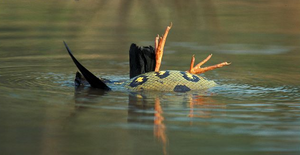This is a list of killing methods that predators employ which you wouldn't want to be a victim of.
Constriction (Constrictors)[]

Most snakes in the past, and some extant species, kill by Constriction. It is, however, only a family of snakes that are able to kill humans, namely the boas and pythons. Constriction occurs when a snake captures prey in its jaws (backward-facing teeth make escape practically impossible from the snake's jaws) and coils its entire body around the prey (it can be any prey, but is more effective on warm-blooded animals). Every time the prey breathes, the snake tightens its grip slightly on the prey, until the prey dies of either blockage of blood flow, or suffocation or drowning. Afterwards, the snake places its mouth over the prey's head and swallows the prey over the course of several hours. Afterwards, the prey will be digested in a number of weeks.
With Humans[]
Nearly all boas and pythons are certainly able to kill humans, but very few species (African Rock Python, Reticulated Python, Anaconda and Burmese Python) are capable of actually consuming adult humans. The shoulders of an adult human would be too wide for a snake to overcome, though some speculate that sufficiently large individuals would be able to pass its mouth over them, though the evidence is insufficient to prove any reported attacks where the snake swallowed an adult. Nevertheless, a number of species are capable of swallowing children, and there are a number of well-documented reports.
Blood Loss (Crocodilians/Sharks)[]

Most predators, including sharks, crocodilians, cats, dogs, and birds of prey tear their prey apart (or at least cut deep scratches into the prey) after capturing it, sometimes when it is still alive. In this case, the prey would continue losing blood until there is not enough blood to power the important muscles, and the prey dies. The crocodile tears its prey apart with the death roll, cats and dogs use their claws and teeth, and birds of prey use their large hooked beak and talons.
With Humans[]
Among all the above animals, only sharks, crocodiles, alligators and the Black Caiman actually pose a noticeable threat to humans, and sharks generally avoid humans. Even when in a group, a human can easily be picked off by a crocodile, and dragged into the water. If the person survives the shock and doesn't die quickly of drowning, they may experience the death roll being used against them (as crocodiles' teeth are robust and blunt for grabbing the prey rather than cutting, otherwise with the extreme jaw pressure the teeth would cut the prey and allow escape). They would experience extreme pain and weakness, and if not treated quickly (should they be saved from the crocodile), would die from blood loss.
It should be noted that crocodiles actually have very weak muscles for opening their huge mouths, and the mouth can be kept shut with only a few layers of duct tape.
Drowning (Anaconda/Frogs/Fish)[]

A number of water predators, mostly fish (with gills) and frogs (which can breathe through their skin), hunt landborne animals. They launch themselves out the water at their prey and drag it underwater until the quarry drowns. Such animals generally swallow their prey whole, as otherwise the prey would die from blood loss. These animals are also heavy with strong jaws, to prevent prey from escaping, and high weight for their size (usually) to anchor themselves. Nearly all such predators are ambush predators, striking when nearby prey leasts expects it. Animals like these can kill animals as large as themselves: the Piraíba, at 3 metres, can eat monkeys and even humans (it's thought they are only scavenged, however), while the 20cm American Bullfrog can eat birds, rodents, snakes, and other frogs, all its own size.